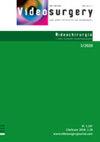腹腔镜袖带胃切除术后缝合线加固对出血并发症发生的影响:回顾性分析
IF 1.9
4区 医学
Q2 SURGERY
引用次数: 0
摘要
导言腹腔镜袖带胃切除术(LSG)作为肥胖症和代谢性疾病的一种治疗方法,其地位日益突出。本回顾性分析旨在评估不同的缝合线加固技术对 LSG 出血并发症发生的影响。材料和方法我们对 2021 年 9 月至 2023 年 4 月期间在本院接受 LSG 的患者进行了回顾性分析。根据钉线加固方法将患者分为两组:连续缝合(53 例)和剪断(28 例)。对手术结果进行了评估,包括手术时间、住院时间和出血并发症。结果连续缝合的手术时间明显更长(88.15 分钟对 74.64 分钟,P < 0.05),但住院时间相似。值得注意的是,连续缝合组未出现出血并发症,而剪切组有 7.14% 的病例出现术后出血(p <0.05)。结论这项回顾性分析表明,与剪切术相比,连续缝合术可增强缝合线的止血效果,降低术后出血风险。尽管手术时间较长,轻微并发症的发生率略高,但这些发现的临床意义应结合患者的个体风险情况来考虑。本文章由计算机程序翻译,如有差异,请以英文原文为准。
Influence of staple line reinforcement on the occurrence of bleeding complications following laparoscopic sleeve gastrectomy: a retrospective analysis
Introduction
Laparoscopic sleeve gastrectomy (LSG) has gained prominence as a therapeutic option for obesity and metabolic diseases. The choice of staple line reinforcement technique in LSG remains a subject of debate, particularly concerning postoperative bleeding complications.
Aim
The aim of this retrospective analysis is to assess the influence of different staple line reinforcement techniques on the occurrence of bleeding complications LSG.
Material and methods
We conducted a retrospective analysis of patients undergoing LSG between September 2021 and April 2023 at our institution. Patients were stratified into two groups based on the staple line reinforcement method: continuous suturing (n = 53) and clipping (n = 28). Surgical outcomes, including operative time, length of hospital stay, and bleeding complications, were assessed. Complications were classified using the Clavien-Dindo classification.
Results
Continuous suturing was associated with a significantly longer operative time (88.15 min vs. 74.64 min, p < 0.05) but a similar length of hospital stay. Notably, no bleeding complications occurred in the continuous suturing group, while the clipping group experienced postoperative bleeding in 7.14% of cases (p < 0.05). Continuous suturing exhibited a slightly higher incidence of minor complications classified as Class I in the Clavien-Dindo classification (7.55% vs. 0%).
Conclusions
This retrospective analysis suggests that continuous suturing may provide enhanced hemostasis along the staple line, reducing the risk of postoperative bleeding compared to clipping. Despite the longer operative time and a slightly higher rate of minor complications, the clinical significance of these findings should be considered within the context of individual patient risk profiles.
Laparoscopic sleeve gastrectomy (LSG) has gained prominence as a therapeutic option for obesity and metabolic diseases. The choice of staple line reinforcement technique in LSG remains a subject of debate, particularly concerning postoperative bleeding complications.
Aim
The aim of this retrospective analysis is to assess the influence of different staple line reinforcement techniques on the occurrence of bleeding complications LSG.
Material and methods
We conducted a retrospective analysis of patients undergoing LSG between September 2021 and April 2023 at our institution. Patients were stratified into two groups based on the staple line reinforcement method: continuous suturing (n = 53) and clipping (n = 28). Surgical outcomes, including operative time, length of hospital stay, and bleeding complications, were assessed. Complications were classified using the Clavien-Dindo classification.
Results
Continuous suturing was associated with a significantly longer operative time (88.15 min vs. 74.64 min, p < 0.05) but a similar length of hospital stay. Notably, no bleeding complications occurred in the continuous suturing group, while the clipping group experienced postoperative bleeding in 7.14% of cases (p < 0.05). Continuous suturing exhibited a slightly higher incidence of minor complications classified as Class I in the Clavien-Dindo classification (7.55% vs. 0%).
Conclusions
This retrospective analysis suggests that continuous suturing may provide enhanced hemostasis along the staple line, reducing the risk of postoperative bleeding compared to clipping. Despite the longer operative time and a slightly higher rate of minor complications, the clinical significance of these findings should be considered within the context of individual patient risk profiles.
求助全文
通过发布文献求助,成功后即可免费获取论文全文。
去求助
来源期刊
CiteScore
2.80
自引率
23.50%
发文量
48
审稿时长
12 weeks
期刊介绍:
Videosurgery and other miniinvasive techniques serves as a forum for exchange of multidisciplinary experiences in fields such as: surgery, gynaecology, urology, gastroenterology, neurosurgery, ENT surgery, cardiac surgery, anaesthesiology and radiology, as well as other branches of medicine dealing with miniinvasive techniques.

 求助内容:
求助内容: 应助结果提醒方式:
应助结果提醒方式:


